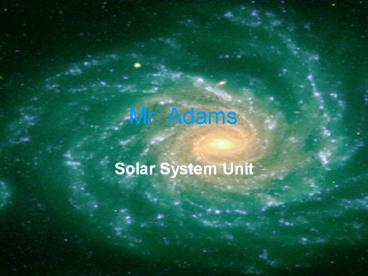Mr. Adams PowerPoint PPT Presentation
1 / 8
Title: Mr. Adams
1
Mr. Adams
- Solar System Unit
2
Solar System Unit
- Science
- Grade 2
- Solar System Unit
- The Solar System, the planets, and outer space
3
Essential Questions
- How does the solar system affect you, the
student? - How does the solar system affect earth?
- How would it affect earth if the sun was smaller
or bigger?
4
Unit Questions
- How are the lengths of a day, a month, and a year
related to the sun-Earth-moon system? - Which is larger -- the sun or the moon?
- Which is further away from Earth -- the sun or
the moon? - How are the movements of the sun, Earth, and moon
related to one another? - Is there life on the moon? Is the moon a ball of
fiery gases, like the sun? - Knowing that the sun rises in the east and sets
in the west, in which direction is Earth
rotating? - How are rotating and revolving different?
- How is your life affected by the changing
seasons? - How does day and night affect plants, people, and
other animals? - What would happen to plant life if the sun were
closer to Earth? - What would happen to plant life if the sun were
farther from Earth?
5
Unit Questions
- Does the moon always appear to be the same shape
in the sky? If not, what shapes have you noticed? - Does the moon actually change its shape every
day? - What animals can you name that are active during
the daytime? during the nighttime? - Why does Mercury orbit the sun faster than the
other planets? - In what year did astronaut Neil Armstrong take
the first steps on the moon? - Why is Mars called the Red Planet?
- Which planet is the largest?
- Which planet is best known for the beautiful
rings around its middle? - In what ways are Uranus and Neptune alike? in
what ways are they different? - What do scientists know about the planet Pluto?
6
Learning Objectives
- The student will be able to identify the nine
planets from pictures with 95 accuracy. - The student will be able to put the planets in
order on paper with 95 accuracy. - The student will be able to explain the
difference between comets and asteroids with 95
accuracy.. - The students will be able to group the planets
into solid and gaseous planets with 95 accuracy. - The students will be able to spell the names of
all nine planets with 98 accuracy. - The students will be able to describe the
rotation of the earth with 90 accuracy.
7
Activities
- Students will draw a picture of the solar system
including the 9 planets and the sun. They will
use multiple colors. And on the back of the paper
they will write their name. - Students will be split into groups and be
assigned a planet. Each group will then do
research to find out specified information about
their assigned planet. Groups will be required
to get at least one image of their planet from an
on-line resource. The information will need to
be put into either a PowerPoint or word document.
8
Activities
- Students will make cards with images of moons and
the names of the moons so that they can play
Memory games to match the moons with their names. - Students will make mobile models of the solar
system including the sun, the nine planets, and
the asteroid belt. For extra credit on this
assignment students can include the moons for
each planet.

